Matador Network's Blog, page 555
December 8, 2021
Can real-life lembas from ‘Lord of the Rings’ be a serious travel food? An investigation.

In J.R.R Tolkien’s The Lord of the Rings series, food is a major character. A good meal makes life worth living for his heroic hobbits, specifically. December 19, 2021, marks the 20th anniversary of the release of the first film in the now iconic trilogy, and while some people might remember the masterful filmmaking or captivating storytelling, I’m still fascinated by all the ways that food pops up in the movies — in particular lembas bread, which are cakes imbued with the elvin magic that can supposedly sustain even the strongest, brawniest men over long journeys.
It’s a dream food for anyone who has debated the perfect fuel to take with them on their journeys. Sure, there’s plenty of advice out there on ideal snacks for hikers, food for backcountry skiers, and what backpackers who want to eat more than trail mix should put in their packs. But a sustaining cake that is both filling and energizing? That, unfortunately, is lacking.
So I decided to make my own. Not just to pay homage to a teenage obsession that I frankly have never given up, but to determine if some (non-magical) version of lembas bread really is worth taking along in your pack on your next big outdoor adventure.
What is lembas bread in Lord of the Rings?Tolkien writes that lembas bread is “made of meal that was baked a light brown on the outside, and inside was the colour of cream.” The elves of Lórien that give the bread to the fellowship instruct them to, “Eat a little at a time, and only at need. For these things are given to serve you when all else fails. The cakes will keep sweet for many many days, if they are unbroken and left in their leaf wrappings…One will keep a traveler on his feet for a day of long labour.”
In other words, it’s pretty much exactly what the fellowship needs to maintain their vigor as they traverse the treacherous, sometimes barren landscape of Middle Earth — especially when you’re being pursued by murderous orcs and there’s little time to stop for a hot meal.
Lembas bread isn’t particularly satisfying for the food obsessed hobbits. In the extended edition of The Two Towers, Legolas warns the hobbits that just a bite of lembas bread will fill the stomach of a grown man. Pippin replies that he’s already eaten four whole cakes.
But what about for the average human person, who isn’t necessarily planning a years long walk across mountains, swamps, and underground tunnels? Could homemade lembas bread be a suitable snack for a mildly taxing hike, perhaps?
How to make lembas bread
Photo: Elisabeth Sherman
In my quest for answers, I scoured the internet for the recipe that best represents what I pictured lembas bread to be. In a scene from The Two Towers, an exhausted Frodo and Sam rest on a craggy mountain side. Sam removes packets of lembas bread from his pack, crumbling and wrapped in leaves, and he laments that it’s all they have left to eat. That’s how I decided my version of lembas bread should look: A cross between shortbread and a cracker that should snap if you break it in half.
I found recipes online that include orange blossom and almonds, but I also always imagined lembas bread as stale and bland, so I decided to forgo recipes that included these ingredients. I eventually settled on this recipe I found on Reddit that gets just a touch of sweetness from honey and a drop of vanilla extract. The other ingredients include flour, sugar, baking soda, and cream — all things needed for a filling snack that provides some energy.
The dough came together easily enough, but it took some experimentation to get the texture right. I ended up baking the square cakes for about a half an hour in order to achieve that snap and golden brown color.
Does lembas bread hold up on a hike?We decided to pack up our lembas bread (wrapped in parchment paper, since I had no leaves on hand) and head to the North Jersey equivalent of the path to Mordor: The Meadowlands. It’s technically a bird sanctuary, but the swampland vibe is the same as the Dead Marshes, as featured in The Two Towers, except New York City is in the background, and there are more majestic herons than restless spirits.
While I didn’t have to carry the One Ring, I did have something equally as heavy: My three-month-old daughter strapped to my chest. We followed the main path, which is part gravel, part dirt and winds around a reservoir that many peaceful ducks call home. The weather resembled a spring day in the Shire. After about an hour, we found ourselves unexpectedly sweaty. Armed with just a canister of water and my version of lembas bread, we decided to park ourselves on a bench and take in some sustenance.
I broke off a corner of one of the cakes for myself and my partner, who remarked that he enjoyed the buttery texture and hint of sweetness that gave an otherwise plain cake a touch of character. “I could eat three of those,” he said.
The takeaway
Photo: Fredy Estuardo Maldonado/Shutterstock
Okay, so it wasn’t exactly enough to fill our stomachs to satisfaction (unfortunately I am not blessed with elven magic), but it did give us the necessary fuel to continue on our journey. It had that crumbly texture that mimicked the real deal lembas bread from the movies, but my version resembled more of a shortbread cookie than a bread or cracker.
We walked for another hour or so until the wind became a little too bracing for the baby, and we decided to head back to the car. Lembas bread doesn’t contain any protein or ingredients that you might find in energy bars, like nuts or chia seeds, that generally give your body the fuel it needs to exercise. So, of course, serious hikers will need to take more substantial fare on their excursions. But it does have some sugar for a quick energy hit that you get from chocolate in trail mix, and it has carbs to sustain hunger for a bit.
For day trips and less challenging hikes, this version of lembas bread is light enough to carry, and it’s a sweet pick me up to enjoy when you start to get tired. If you’re planning to track a pack of orcs through Rohan, however, you’re going to need that elven magic.
Go beyond the beach with these historic things to do in Turks and Caicos

TO THE BEST OF anyone’s knowledge, the Junkanoo Museum just down the road from the Providenciales airport is the only museum in the world that announces your arrival with a long blast from a conch shell.
It’s the customary welcome from Kitchener Penn from within the lobby of his museum, surrounded by elaborate Carnival costumes. Penn is the leader of the We Funk Junkanoo Band, and right now, he’s blowing a traditional fisherman’s horn once used by local mariners to announce their arrival before the advent of radio.
His museum is a beautiful foray into the culture of the Turk islands that nearly every visitor zooms past in a taxi on their way to a luxurious Grace Bay resort. Most travelers prefer to post up with piña coladas, marvel at the turquoise water, and stay near the resort, forgoing most opportunities for island exploration.
Not to say that’s not a worthwhile vacation for some, but you could easily do that in Florida or somewhere closer by — and more importantly, spending all your time at a resort misses so much of what makes Turks and Caicos special.
On your next trip, do yourself a service: take the time to leave those comfy confines and you’ll quickly learn Turks and Caicos is full of vibrant culture. Across the island, you’ll find flamingos and artisan vendors roaming steps away from centuries-old ruins. You’ll see surf pounding limestone cliffs along scenic trails, and heavenly beaches hidden behind colorful shacks. The Turks and Caicos are a lot more than the just the expensive resorts advertised on travel-booking websites, and it takes surprisingly little effort to discover the island’s fascinating history and culture.
Explore the curious, colorful history of junkanoo
Photo: Laura Grier
“Slaves,” Penn says, putting down his conch horn and showcasing a junkanoo costume made from strips of ripped fabric that resemble a colorful cloth mop. “They would cut up old clothes to make the costumes. That’s why they call it junk-anew!”
Whether that’s the real origin of the name is debatable, as is the origin of the celebration itself. Penn, along with most historians, agrees that Turks and Caicos’ junkanoo dates back to the islands’ slave era (which ended in 1834), when Christmas and New Years were the only breaks slaves got. Making the most of their brief respite, they celebrated by dressing in elaborate garb and playing music with whatever instruments they could find. The tradition evolved into ever-more-elaborate costumes, better instruments, and parades on Boxing Day (December 26) and New Years Day.
On a tour, Penn shows guests the full-body costumes in his museum. They’re brightly-colored gladiators representing the indigenous melon cactus, conch shells, and flamingos. After the tour, guests return to the lobby for an introduction to ripsaw, a music genre that originated on the islands. It’s akin to a Caribbean percussion jam band made up of goat skin drums, a metal saw, and milk jugs-cum-maracas. The music is a tribute to the improvised instruments of the slave era.
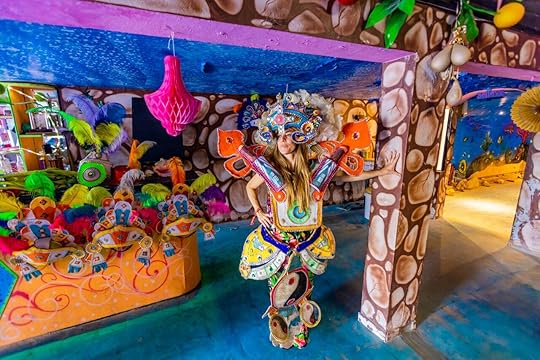
Photo: Laura Grier
“The new generation,” Penn says during a break, “they mix the ripsaw with other music, from Jamaica and other places. So you won’t see the old kind that much anymore.”
It’s not just a case of “kids these days,” either: Penn is aging, and no obvious successor has stepped up to lead his We Funk Junkanoo Band. There’s no way to say if the tradition will eventually die with him, but it is — at best — in peril. Visiting the museum is one of the most culturally enlightening things to do in Turks and Caicos, but it may not be an option forever.
Find untamed wilderness in North and Middle Caicos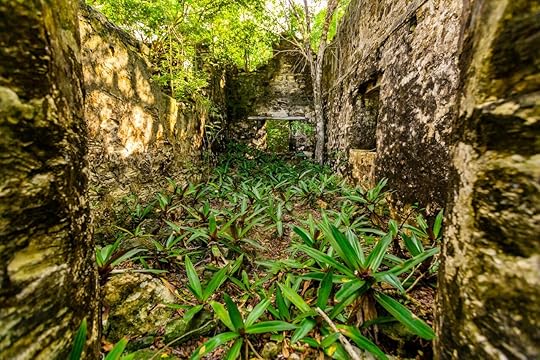
Photo: Laura Grier
Much like you may expect from any damp location that hasn’t yet been paved over, the mosquitoes in North and Middle Caicos are no joke. And though you’ll reach the islands from a short ferry ride from Provo, locals joke that the mosquitoes could probably carry you faster. But as long as you arm yourself with a can of bug spray, you’ll have an amazing time exploring these large, sparse islands that hold Turks and Caicos’ most scenic spots.
North Caicos is home to the Wade’s Green Plantation, an 18th-century plantation to which many Turk islanders — mostly descendants of slaves — can trace their family lineage. The massive, 3,000-acre space grew cotton, sugarcane, and agave-like sisal plants. At one time, it housed over 384 slaves and was the largest of the islands’ “loyalist” plantations: those granted to British sympathizers when their land was seized after the Revolutionary War.
Today, touring the ruins is one of the best things to do on Turks and Caicos for history lovers or nature-lovers; it’s beautiful and overgrown with tropical foliage. The juxtaposition of the grey stone and sprawling flora is eerily beautiful and a fantastic lesson in both the island’s history and vegetation.
You’ll reach Middle Caicos if you head south along the outer islands’ lone road, where you’ll see signs pointing to a little spit of sand called Bambara Beach. Here, a grove of casuarina pine trees stand over a row of pastel-colored shacks. Both of them front a blinding white beach with the islands’ trademark turquoise waters.
The shacks sell everything from local crafts to conch fritters. Outside shack three is the usual spot for locals to stand around drinking beer, like a still from a Caribbean “King of the Hill.”

Photo: Laura Grier
Time seems unimportant here and the soft breezes and green waters will likely hypnotize you into forgetting how long you’ve stopped. Bambara is the epitome of a Turks and Caicos paradise, but it’s unusual to see more than one or two tourists. Of course, it’s a bit of an ordeal to reach as you’ll need to rent a car at the ferry terminal or hire a driver. But worth it for this kind of idyllic isolation.
Middle Caicos also boasts the most scenic hike in the islands: the Crossing Places Trail. While the islands are generally fairly flat, you’ll find a little slice of the British Isles beginning near the Dragon Cay Resort.

Photo: Laura Grier
The jagged coastline that runs from the resort at Mudjin Bay over the northern shore of Middle Caicos is a winding journey of limestone cliffs, crashing waves, and secluded beaches. Hiking the 4.6-mile, out-and-back trail is one of the best things to do on Turks and Caicos for adventurers who want to hear a constant soundtrack of fierce waves belting the shore and have endless views of the waves rolling in — the trail is near a pretty decent surf break.
Learn about history beyond the cruise port in Grand TurkTurks and Caicos’ other frequent stop is Grand Turk, but that “stop” is often little more than a cruise ship port of call filled with fruity drinks and duty-free jewelry. But Grand Turk is home to almost all that is historic about the Turks and Caicos. It was the islands’ first major commercial settlement and one of the world’s leading salt producers for 300 years.

Photo: Laura Grier
Though the salt industry has been dormant since the 1960s, salt ponds still cover the center of the island and are home to flamingos and other migratory birds. It’s the kind of urban wildlife refuge you typically see in places like the Galapagos, and visiting is one of the best things to do in Turks and Caicos near the port. It’s a peaceful meditative spot barely a mile from where the ships dock.
However, if you really want to dive into the economic history of salt, book a ride alongside tour guide Robert Hall. Once a local politician, Hall now tours visitors around his home island with an unparalleled depth of knowledge and a voice that, if you close your eyes, sounds exactly like Darth Vader (in a soothing way). Most hotels and restaurants should know how to get in touch with him.
“Grand Turk provided much of the salt used by American troops during the revolution,” he says. “George Washington was probably giving his men salt from Grand Turk.”
He takes us along Front Street, a narrow strip of colonial homes dating back hundreds of years. They’re now inns, restaurants and private residences. “When the salt industry was introduced in 1665, horses and donkeys were brought in to pull the carts of salt from the Salinas [salt marshes] to the boats,” Hall says as we drive by Front Street’s concrete walls. After a few years of many of the merchants being sued for damages their animals did to homes, lawns, and doors, the merchants lobbied together to pass a law that said the animals weren’t responsible for damages unless they managed to scale an 8-foot-tall wall. That shifted the onus of responsibility to the home owners, all of whom were forced to build massive walls around their properties. Many of them still stand today.
In the middle of the street, one mansion-turned-home converted its oceanfront garage into the Sandbar Beach Bar, where guests of the Manta House (and anyone else) can cool off with an oceanside beer or snack. It’s also a shared office for Grand Turk’s work-from-paradise set and usually filled with young professionals sweating behind their laptops while intermittently swatting mosquitoes.

Photo: Laura Grier
Hall drives up to the beaches along the northern peninsulas of Grand Turk, another slice of Caribbean paradise tourists haven’t discovered. We wind up the hills to an abandoned British navy base turned into an amusement park, though it was again abandoned when cruise ships left during the pandemic. It’s easy to notice the overgrown zip line tower in front of a shuttered souvenir shop and crumbling barracks. The place is a poetic relic to two eras gone by.
Hall makes it his goal to convince travelers that Grand Turk’s meandering history, from salt hub to tourist town, makes it worth far more than a six-hour port of call. It deserves exploring beyond the tourist traps, as do the rest of Turks and Caicos, with their untouched wilderness and colorful culture.
Sure, a relaxing week at a luxurious hotel isn’t necessarily a bad idea, but the islands offer plenty more for visitors who want more than pure relaxation. Visiting these places may take a bit more logistical planning — and a good deal more bug spray — but exploring some of these things to do in Turks and Caicos beyond the beaches is a rewarding experience. You’ll just need to pull your eyes away from that shimmery, turquoise-blue water first. 
This is the most over-the-top and expensive spa treatment in the world

We all love a good pampering, and if you’ve already splurged on a luxury stay, why not go all out and top off your vacation with a visit to the spa? Because yes, forking out $200 for a dreamy massage is always worth it. But if that price point is making you cringe, wellness and relaxation specialists at CFAH are about to blow your mind with their list of the most expensive spa treatments. In ascending order, here are the five most expensive pamper sessions around the world.
5. L’elixir Des Glaciers Majestic Treatment, Eau Palm Beach Resort and Spa, FloridaThe L’eixir Des Glaciers Majestic Facial Treatment at the Eau Palm Beach Resort and Spa in Manalapan, Florida will set you back $705. The treatment claims to rid you of signs of aging using the power of honey, purifying propolis and regenerating royal jelly. You’ll also get a relaxing upper body massage.
4. Caviar Journey, St. Regis Maldives Vommuli Resort, MaldivesThe St. Regis Maldives Vommuli Resort lists their Caviar Journey for $750. Believe it or not, they state anti-aging properties of caviar extract revitalizes skin! After you’ve been covered in caviar, you can enjoy a warm lavender bath and a glass of Champagne with views over the Indian Ocean.
3. A day of Gold, Emirates Palace Spa, Mandarin Oriental, Abu DhabiIn Abu Dhabi enjoy A Day of Gold at the Emirates Palace Spa, Mandarin Oriental for $1,150. The spa itself is stunning, with amenities such as Jacuzzis, two steam rooms, heated marble and an ice cave. The treatment includes a hammam steam bath, a massage, lunch, and then a 24-Carat Gold Facial — topped off with a pedicure.
2. The High-Tech Facial, The Peninsula Spa Beverly Hills, CaliforniaAt The Peninsula Spa Beverly Hills in sunny California a high tech facial is on the menu for a whopping $1,500. The treatment combines light therapy, anti-aging peptides, and an intelligent carrier system that supports skin cells, reduces aging, and retains moisture.
1. 24-Karat Gold Mask, Talise Ottoman Spa at Jumeirah Zabeel Saray, DubaiThe most expensive treatment of all will cost you $6,800 — a 24-Karat Gold Mask at the Talise Ottoman Spa at Jumeirah Zabeel Saray in Dubai. The treatment starts with a cleanser and exfoliate. Then the gold chain mask is applied using an electric current. Afterward, you can enjoy an Arabian gold hammam and a rose oil Jacuzzi followed by a Champagne and caviar lunch and a premium gift bag. The award-winning mask is said to be worth the hype and price tag.
Other expensive spa treatments include:
The Ritz-Carlton New York, Ultimate Platinum Rare Facial $695The Al Messila Spa, Doha, Qatar, Golden Opulence $604The Peninsula, New York, Detox and Adrenal Program & Renew and Revive Journey $590Spa Radiance, San Francisco, Biologique Recherché Quadruple Lift Facial $575Waldorf Astoria Los Cabos Pedregal, Mexico, The Awakening Moon, the Nourishing Moon, the Calming Moon, and the Restoring Moon $450Amani 180 Spa, Greece, Alonnisos, Pearl of Africa $398.41Would you spend this much for a fabulous glow? 
This couple traveled the world for under $50/day and this is how they did it

The life of a nomad, digital or otherwise, is blessed with unfettered freedom, simple pleasures, and intrepid experiences. Unsurprisingly, it’s growing in popularity by the year, but deciding what form of travel — backpacking or van life — is best for you and your budget requires a little consideration.
Before I was a travel writer, I was earnestly searching for ways to stay on the road longer. I spent a year with my fiance, binging street food and wandering foreign cities as a backpacker. When the pandemic dashed all hopes of continuing, we traveled closer to home in a hastily built and albeit questionably mechanically sound campervan. By meticulously documenting our every expense, I discovered that full-time travel can be achieved for about the same cost as renting a one-bedroom apartment in the United States. But which version of long-term travel is more cost-effective for budget-conscious travelers — van life or traditional backpacking?
It’s not just the cost of the two lifestyles that vary greatly, — the cost does differ dramatically between the two — it’s the day-to-day experiences that diverge as well. When comparing the two lifestyles there are several factors to dig into; start-up cost, day-to-day cost, and experiences offered. This will help you decide which kind of travel is right for you.
How much does it cost to start backpacking?How much does van life cost to get started?How much does it cost to backpack the world?How much does van life cost?A day in the life of a backpackerA day in the life of a van liferWhat is better? Van life or backpacking?How much does it cost to start backpacking?
Photo: Geena Truman
Very little. One of the major benefits of the backpacking travel style is that the start-up costs are limited to a decent backpack. But even that is negotiable. You’ll want to pack light and there is no need to completely redo your entire wardrobe before a big trip. Instead, you’ll get to save all that money for adventures on the road. My backpack cost $150.
How much does van life cost to get started?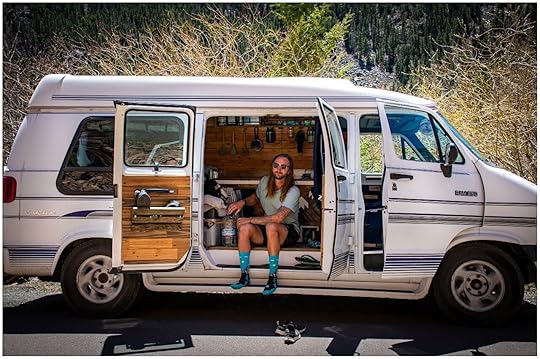
Photo: Geena Truman
Van-dwelling can be cost prohibitive to many solely due to its high start-up cost. For starters, you need to have a vehicle conducive to van-living. Then there is the matter of the van build itself. Van builds vary in cost, from nearly free if you were to remove your back seats and throw in the bare essentials, to $100,000 luxury Sprinter Vans crafted by professionals. My 1994 high top Dodge Ram Van cost $4,000 and the build another $3,000 in total.
How much does it cost to backpack the world?
Photo: Geena Truman
Conceivably, truly dedicated penny-pinchers could travel the world on $10 per day, but only if they are willing to live like a vagrant and pass on many of the major attractions. This day-to-day budget is instead geared toward travelers that won’t hesitate to splurge on epic unmissable experiences.
Keep in mind that countries like India, Cambodia, and Indonesia are inherently budget-friendly destinations. Had we decided to throw more expensive places from Europe or the United States into the mix, it would have driven up costs immensely. We averaged only $11.66 per night on lodging, which typically included a home-cooked breakfast. Each meal only cost us about $1.96 per person otherwise. Long-haul flights across the Pacific and Atlantic oceans, at the beginning and end of our trip, drove up our transportation costs by nearly $1,400. Our miscellaneous category includes replacement clothes and gear lost or irreparably damaged along the way, as well as small but necessary expenses like bathroom-use fees. We were able to save a fortune on drinking water by investing in a Lifestraw Filter bottle before the trip.
Day-to-day budget breakdown for 12 months in South East Asia, Asia and South America$5,064.89 — Transportation (planes, trains, Uber, taxi)$4,255.90 — Accommodation$3,300.31 — Activities and entrance fees$2,861.60 — Restaurants and food$689.35 — Miscellaneous$380.00 — Visa and government fees$117.85 — Water bottles$84.00 — ATM fees and conversion costs$58.00 — LaundryTotal: $16,811.90 or $46.06/day for two people
How much does van life cost?
Photo: Geena Truman
Full Disclosure: This budget does not include the three catastrophic breakdowns we experienced on the road. Alternators, fuel pumps, and electrical work ran up the bill an additional $2,100 in van repair costs. The truth is old vans are notoriously unreliable. This is simply a risk you take.
Unsurprisingly, gas dominated our vanlife budget. We moved often, just as we would have had we been backpacking the world, in a vehicle that gets only 15MPG on a good day. Being the foodies we are, eating lobster rolls in Maine, buffalo burgers in Montana, pizza in New York, and fried chicken in Georgia devoured more than a quarter of our total budget. We were able to save a large chunk of change as we made it our mission to evade paying for parking and overnight camping at every turn.
Water is another van essential. You will need it for dishes, for drinking, for cleaning, and even for bathing. In many states, like Utah and California, we were able to refill our water for free, but metropolitan areas proved trickier and more expensive to find water. Our overnight accommodations and parking costs were greatly inflated because we chose to drive the Baja Peninsula in the sweltering summer months without air conditioning. Forced out of the van by 100+ degree temperatures, we sprung for hotels on seven separate occasions in Mexico.
In the end, we spent ten months in the United States and one each in Mexico and Canada. Due to the fact the Baja Peninsula is the most expensive region in Mexico, we found that our day-to-day expenses were nearly the same in all three countries.
Day-to day budget breakdown for 12-Months of van life in USA, Mexico, Canada$8,787.60 — Gas$8,429.04 — Restaurants and groceries$1,553.10 — Breweries and post-hike beers$688.23 — Parking and overnight accommodation$373.30 — Van maintenance$240.30 — National parks pass and state parks fees$164.00 — Extra gear and replacement stuff$136.00 — Entertainment and activities$136.00 — Propane$130.04 — Water$50.40 — Laundry$39.80 — Bathroom expences$7.60 — SouvenirsTotal: $20,735.41 or $56.81/day
A day in the life of a backpacker
Photo: Geena Truman
During our year of international travel, we visited 17 countries in places around South America, Southeast Asia, and South Asia. We took flights for the major ocean crossings but otherwise roughed it, traveling overland by bus and train. We woke up in private rooms at small family-run guesthouses or the occasional rickety black-metal hostel bunk. We spent our days trekking volcanoes, exploring unfamiliar streets, visiting temples, lounging on beaches, and immersing ourselves in local life. Our most costly expeditions saw us trekking to see Orangutans in Sumatra, floating the Mekong river, dancing through the technicolored celebrations of Holi in India, and canoeing the murky chocolate-colored waters of the Colombian Amazon. We savored local cuisines in restaurants and street food markets, never setting foot in a supermarket because often, it was cheaper to eat out.
A day in the life of a van lifer
Photo: Geena Truman
Van-dwelling is a polarizing subject. To many, the idea of living in a 30 square foot box is unappealing, to say the least. But for seasoned backpackers used to weathering discomfort in the pursuit of grand adventure, it seemed like the logical step when international travel went up in a poof of smoke. We wanted to see the United States, and we wanted to do it on a shoestring budget.
Once we purchased an old beater van, renovated it, and hit the open road, our day-to-day was filled with stunning vistas and monotonous chores. We would often wake in Wal-Mart parking lots, spend several hours driving to the next destination, and then enjoy some much-needed time in nature. We kept our costs relatively low by focusing on the bountiful natural wonders of the USA, namely the national parks. We drove nearly every day, with the lofty goal of exploring the entirety of the United States, the Baja Peninsula of Mexico, and British Columbia, all within one year of van-dwelling. We weren’t simply living in a van; we were traveling in a van. We hiked to panoramic peaks in 37 national parks, sampled the varied cuisines of America, and explored iconic cities on foot. We traversed the rim of the Grand Canyon, snorkeled in the tropical waters of La Paz, and spotted salmon-munching black bears on Vancouver Island — all while maintaining a tiny home of wheels and deciphering crumpled road maps.
What is better? Van life or backpacking?Each nomadic lifestyle has its ups and downs. But for myself, and likely most other travelers, backpacking wins outright. From a strictly cost perspective, vanlife is more of a risk. Potential breakdowns, maintenance, and an often steep start-up price tag deter would-be van-dwellers from ever leaving their driveway. Once on the road, vans guzzle gas which makes exploring a country as vast as the United States cost a pretty penny.
From an experiential perspective, the two lifestyles couldn’t be more different. Van-living is peppered with chores and undesirable daily tasks, like finding a free or cheap place to park each night and keeping your “house” reasonably clean. International travel allows you to push those unsavory tasks onto restaurants and guesthouses without blowing your budget. You’ll also trade leisure time spent gazing out bus windows for hours in the driver’s seat.
The biggest difference between the two travel types, aside from nearly $4,000 in day-to-day expenses, is the monotony. van life offers a level of routine not often experienced by the avid backpacker. Occasionally this repetition in tasks and experiences can be comforting to the perpetual traveler, but most often, you will find yourself yearning for something new. van life allows you to travel within a bubble, protected from the unfamiliar, which is a stark contrast to the full immersion in local cultures and customs that a backpacker is likely to experience abroad.
Van-dwelling is a worthy endeavor for any budget traveler. You’ll find a greater appreciation for the roads between the destinations and the dramatic landscapes and nuances of your home country. It’s not without its charms. But when it comes down to pinching pennies and collecting meaningful experiences- backpacking will always offer the most bang for your buck. 
December 7, 2021
Amazing Christmas window displays

One of the most enjoyable parts of the holiday season isn’t gift-getting, gingerbread house-making, or tree-decorating — it’s perusing eye-catching Christmas window displays. This time of year, stores go all out to make sure you’ll check out their wares, even if you never actually set foot inside the store itself. From scenes from Christmas movies to beautiful light displays that will make your jaw drop, here are six of the most amazing Christmas window displays around the world that you should check out this holiday season.
1. Macy’s Herald Square, New York City
Photo: Courtesy of Macy’s
One of New York City’s longest-standing Christmas traditions is the holiday window decorations at Macy’s, and this year, the theme for the six animated and interactive window displays is “Believe”. The star of the Christmas window displays, and the rest of the store’s facade, is Tiptoe, an adorable deer whose dream is joining Santa’s team. Check out all the window one by one to take in Tiptoe’s story as she goes to flight school and studies to achieve her goal. Thanks to the support of all her friends and her hard world she finally gains the self-confidence she needed to fly with Santa’s wonderful crew this Christmas. Macy’s Herald Square’s holiday windows can be seen on the Broadway side of the flagship store until January 1, 2022.
Where: 151 W 34th Street, New York
2. Saks Fifth Avenue, New York City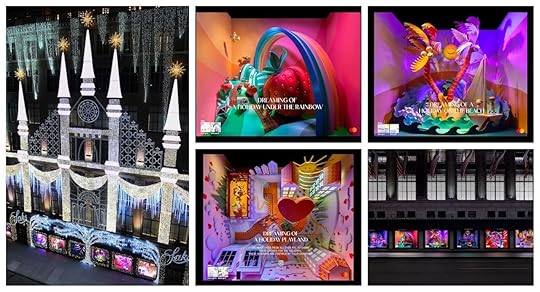
Photo: Courtesy of Saks
This year, Saks Fifth Avenue’s windows are decorated on the theme of reconnecting with family and loved ones during the holiday season. The six windows in the center of the store’s facade have been directly inspired by the responses of New York children who were asked to draw and describe what they dream of doing with loved ones for the holidays. The result is vibrant diplays featuring scenes of holidays on the beach, holidays under the rainbow, and sweet holidays at home, and more.
Of course, this year, like every year, Saks’ amazing light and music show, including 700,000 programmed LED lights on the ten-story-tall facade of the building, will be on display until January 4, 2022.
Where: 611 Fifth Avenue, New York
3. Galeries Lafayette, Paris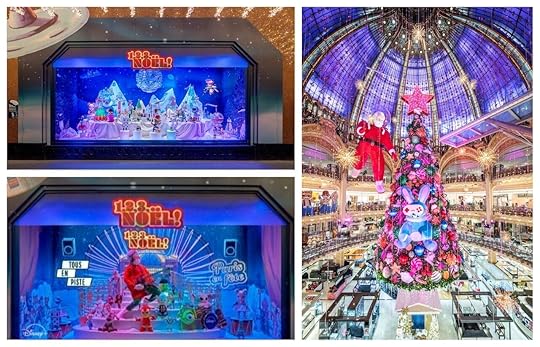
Photo: Galeries Lafayette/Facebook; Galeries Lafayette
The Galeries Lafayette is well-known for its architectural details that makes the department store gorgeous year-round, but, every year, the beauty of the decor kicks up a notch with the holiday season. This year’s theme for the Galeries’ Christmas ornamentation is a surrealistic Christmas tale titled “1, 2, 3, NOËL”. The 11 Christmas window displays are filled with a mix of vintage and futuristic automatons and gifts, and each window illustrates one part of the story.
Inside the store, a four-story Christmas tree is placed under the cupola alongside a floating astronaut Santa and a futuristic toy rabbit. The tree is crowned with large pink star and filled with superb and colorful ornaments. Every 30 minutes, the stores goes dark and visitors can enjoy sound and light show.
This year, for the first time in the history of the store, the ornaments (all handmade) from the Christmas window displays and the Christmas tree are for sale. The proceeds from this sale will go to a charity helping hospitalized children and teenagers.
Where: 40 Boulevard Haussmann, Paris
4. Harrods, London
Photo: Pit Stock/Shutterstock; Harrods/Facebook; Harrods
Being London’s most famous department store, expectations are high for Harrods when it comes to holiday decorations. This year, the store’s theme for its Christmas window displays is that of a holiday feast, with nine ground-floor windows designed to look like one long and lavish dining table that stretches along Brompton Road. The “table” bears luxurious Christmas feast items including a bottle of bubbly covered in gems, chrome-color crackers, gooey Christmas puddings, and a rack of lamb paired with whiskey bottles. All nine windows are lit in holiday-appropriate colors such as green, red, and silver, and are extravagantly decorated with sparkles and mirrors.
This year, Harrods has also dedicated five of its windows and its Door Five entrance to the 100 year anniversary of the famous Chanel N°5 fragrance. And if you manage to find and keep good count of all the miniature N°5 bottles hidden in the five windows, you’ll receive a gift at the store’s CHANEL beauty counter.
Harrods holiday windows can be seen until early January 2022.
Where: 87-135 Brompton Road, Knightsbridge, London
5. Selfridges, London
Photo: Courtesy of Slefridges
This year, the theme of Selfridges’ Christmas window displays is “Christmas of Dreams”. After two difficult years in the English capital, the department store is inspiring shoppers to make the most of the magic of the holidays with minimalistic and dream-like scenes set up in its windows for everyone to see.
This year, for the second year in a row, Selfridges has organized a Christmas Market filled with local food vendors, artisans, and even Santa and his elves. Selfridges’s Christmas market stretches along the whole of Edward Mews and takes place daily until December 24.
Where: 400 Oxford Street, London
6. Bloomingdale’s, New York City
Photo: Tom Sibley, courtesy of Bloomingdale’s
Bloomingdale’s on Lexington Avenue between 59th and 60th streets in New York City always has an impressive window display, and this year the store is continuing its tradition. Six windows decorated on the theme “Give Happy” brighten up the store with beautiful scenes. One shows a penguin family in its igloo home, all dressed in fashionable attires; another is a modern take on a music box, with a spinning figure emerging from a seashell. But our favorite is window five and its strange hybrid Christmas tree-dinosaur that’s riding a skateboard.
Where: 1000 Third Avenue 59th Street and, Lexington Avenue, New York 
A version of this article was previously published on December 5, 2019, and was updated on December 7, 2021, with more information.
More like thisHolidays7 amazing European Christmas markets you need to go to this holiday season20 years later, here is how “The Lord of the Rings” has changed New Zealand

20 years have passed since the release of the first film in The Lord of the Rings (LOTR) trilogy. And a lot has happened since December 10, 2001. iPhones and Netflix’s streaming service have been invented; Blockbuster has vanished. “The world has changed,” Lady Galadriel presciently said in the opening scene of The Fellowship of the Ring. What hasn’t changed, however, is our love for Middle Earth.
The movies captured our imaginations with snowy mountain peaks and rugged, untouched wilderness; of wild plains, bucolic villages, and treacherous caverns. It introduced us not just to Tolkein’s unfailable imagination, but to the very real landscapes of New Zealand, where the movies were filmed.
After the trilogy gained international popularity, New Zealand became synonymous with Middle Earth. That popularity only continued with the subsequent release of The Hobbit films in 2012. That year, Gregg Anderson, general manager of Western long haul markets for Tourism New Zealand told Forbes, “We’ve seen a 50 percent increase in arrivals to New Zealand since Lord of the Rings.”
If anyone deserves to celebrate the 20th anniversary of the LOTR trilogy, it’s New Zealand. The Hobbiton movie set is marking the occasion on December 10, 2021, with an outdoor screening of the films — the first-ever 4k screening of the movies in New Zealand. Weta Workshop, the creative force behind the movies’ costumes, props, and set design, is launching a Bag End™ collectible sculpture and an exhibition of film costumes in Wellington on the 20th. There’s also the first-annual Middle Earth Halfling Marathon taking place through the Hobbiton Movie Set and the surrounding hills of the Waikato farmland, but that’s not until April 2, so there’s plenty of time to get in shape. It’s worth noting, however, that borders remain closed to international visitors through April, 2022, so you might be off the hook from actually running unless you live in New Zealand.
Here at Matador Network, we’re celebrating in our own way, with an interview with Sarah Handley, General Manager of Tourism New Zealand for the Americas and Europe. We talked about all things LOTR tourism, including the movies’ impact on the country’s tourism economy, how New Zealanders actually feel about living in Middle Earth, and even the highly-anticipated Amazon adaptation of The Lord of the Rings.
How did the LOTR trilogy impact the New Zealand tourism landscape?International travelers have always been drawn to New Zealand’s epic landscapes and friendly people. The success of the Lord of the Rings films has definitely had a significant impact on tourism, essentially propelling New Zealand as a destination onto the world stage. In 2019, 18 percent of people who visited New Zealand for a holiday were initially interested in New Zealand as a destination due to the Lord of the Rings and Hobbit films. For nine percent of those, it helped them seriously consider New Zealand as a holiday destination, and we know in the same year 33 percent of all people that visited New Zealand for a holiday visited a film location. For the most part, our tourism industry is proud to continue to offer the same authentic and unique experiences that New Zealand was known for prior to the film’s release, but there is no doubt the exposure these films generated increased the visibility of New Zealand on the world stage.
Did the Hobbit movies give the tourism industry another boost?The release of the first Hobbit film in 2012 gave New Zealand the opportunity to remind the world it is the home of Middle Earth by showcasing our breathtaking landscapes on screen again. To coincide with the release, Hobbiton Movie Set, New Zealand’s most popular tourist destination, rebuilt a number of their Lord of The Rings sets and opened the famous Green Dragon Inn. They saw a steady increase in visitors as a result.
How many visitors come to Hobbiton each year?In 2012 (when the Hobbit films debuted) approximately 150,000 people enjoyed the Hobbiton experience, this has since grown significantly to 650,000 people in 2019 (their biggest year yet). We estimate that visitors who are influenced to visit New Zealand due to the Lord of the Rings and Hobbit films contribute approximately $630 million NZD ($428 million USD) annually to the economy, however, the true value to New Zealand in terms of brand exposure and reputation is much greater.
What are some of the most popular LOTR tourism sites in New Zealand?Hobbiton, located in the Waikato district, is undoubtedly the most popular film tourism attraction in New Zealand, however, there are several other film tourism experiences visitors can enjoy. Touring the famous Weta Workshop and Studio for an insight into filmmaking creativity in Wellington is a great way to learn about the making of movie effects. In Queenstown, you can take a 4WD or helicopter tour to see up close some of the most dramatic landscapes used as locations in the Lord of the Rings films. In Nelson, you can visit the workshop where they made the original gold ring for the LOTR films, you can even take one home with you!
What about sites that aren’t LOTR-focused?International visitors have endless destinations to choose from once they get to New Zealand. Popular cities and attractions are Queenstown (our outdoor adventure capital), Rotorua for geothermal experiences and rich Maori culture, The Bay of Islands for sailing, white sand beaches and forests, and of course the Marlborough region to sample our famous Sauvignon blanc and seafood.
Has there been any pushback about leaving sets like Hobbiton intact in these otherwise unspoiled natural environments?The Hobbiton movie set was created on private farmland and designed in a way to minimize impact on the natural environment. As a business, Hobbiton recognises the community they operate in and run various initiatives to support it such as open days, fundraisers, and school events. New Zealand has strict regulations when it comes to filming in outdoor locations and the natural environment, including national parks which adopt a ‘leave only footprints’ policy.
How do the people of New Zealand generally feel about being associated so closely with Middle Earth? Is there any resentment, or do they fully embrace the films that brought the country so much attention?Generally, New Zealanders are extremely proud to have their country be associated as the home of Middle Earth. The films had a huge impact on our country’s reputation and built the foundation for what is now a thriving screen production industry. Nearly every New Zealander who has travelled overseas at some point has encountered the phrase “New Zealand, that’s where they filmed The Lord of The Rings, right?”
Any details you can share about the upcoming LOTR Amazon series?Amazon produced the first season of their new Lord of The Rings series in Auckland with location filming taking place around the country. Fans can expect to see some stunning New Zealand backdrops in the first season scheduled to be released in September 2022. 
8 gorgeous Roma Norte Airbnbs in Mexico City’s artsiest neighborhood

Roma is, along with La Condesa, one of the centers of the hipster culture in Mexico City. It hosts many Art-Nouveau and Neo-Classical architectural gems, which gives it a European feel, and it’s now home to trendy restaurants, cafes, and shops. The area of Roma-Condesa was designated as a barrio mágico (“magical neighborhood”) by the city in 2011. Along with Polanco, it’s among the most popular barrios for visitors in the city. Here are the best Roma Airbnbs in the heart of Mexico City.
We hope you love the Roma Airbnbs we recommend! Just so you know, Matador may collect a small commission from the links on this page if you decide to book a stay. Listed prices are accurate as of the time of publication. See our full Advertiser Disclosure here.
Elegant, sunlit apartment in an unbeatable location
Photo: Airbnb

Photo: Airbnb
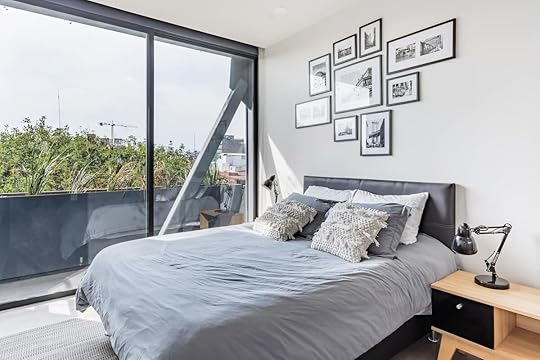
Photo: Airbnb

Photo: Airbnb
This artsy apartment is bright and airy, an inspiring jumping off point for exploring one of the world’s most vibrant cities. The views are good, the decor is clean, and the place feels like what you’d want your urban loft to look like. Former guests have raved about its clean, modern design, its location, the extra touches from the host (think a welcome wine basket with snacks), and the high-speed Internet.
Five guests, two bedrooms, two bathrooms
Price: $146 per night
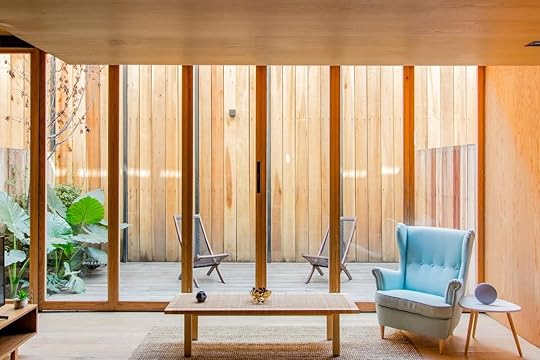
Photo: Airbnb

Photo: Airbnb

Photo: Airbnb

Photo: Airbnb
This gorgeous unit epitomizes the culture of Roma. It’s clean and modern, but uniquely could not be anywhere else but this neighborhood, at this time. It’s good for remote work and for patio happy hours. It also offers easy cafe access. Centrally located and tastefully decorated and designed, all the guests agree: this apartment is beautiful.
Three guests, one-bedroom, one and a half bathroom
Price: $114 per night

Photo: Airbnb

Photo: Airbnb

Photo: Airbnb
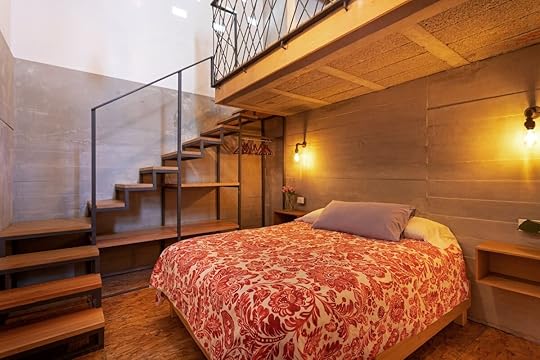
Photo: Airbnb
This apartment is exceptionally well located, it has a super fun layout, it’s very safe and cutely decorated. The unit features an upstairs and downstairs area with sleeping quarters, and is bright enough to spur even non-morning persons into action for a day out in Mexico City. Of all Roma Airbnbs, this one is perhaps the most well-lit and inspiring.
Four guests, two bedrooms, one bathroom
Price: $68

Photo: Airbnb



The location of this oasis apartment is perfect: away enough from restaurants and bars but within a short walking distance to everywhere. The apartment is at the top of the building and the rounded-shaped windows, the high ceilings, and the views create a general ambiance of peace and calmness. Be aware that there is a spiral staircase to get up to the apartment. There are bunk beds in one of the bedrooms that are great for kids or friends who don’t mind sharing a room. The master bedroom is traditional and open.
Four guests, two bedrooms
Price: $111 per night

Photo: Airbnb

Photo: Airbnb

Photo: Airbnb

Photo: Airbnb
This beautifully decorated, spacious apartment is extremely well equipped (think safe drinking water, a washer, a dryer, and all the kitchen gadgets). It’s close to everything, and the views from the fifth-floor wraparound terrace are simply astonishing and worth the investment. Plus, it has a dedicated workspace and guaranteed fast wifi — making this an ideal spot for remote workers.
Four guests, two bedrooms, three and a half bathrooms
Price: $130 per night
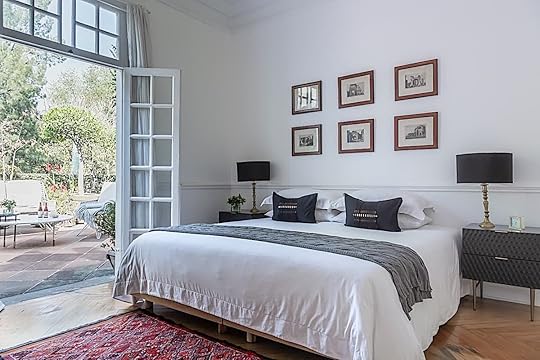
Photo: Airbnb

Photo: Airbnb
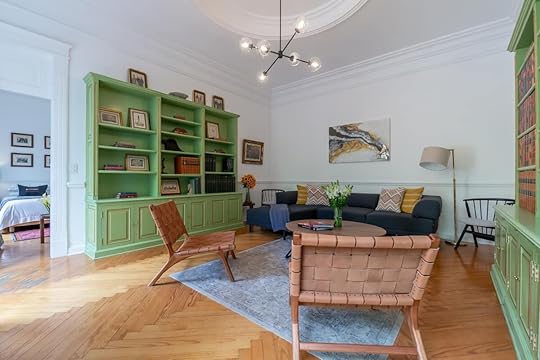
Photo: Airbnb
This seductive apartment is located on a tree-lined street overlooking the beautiful and lush Rio de Janeiro park, one of the highlights of la Roma Norte. The terrace is full of flowers, butterflies, and hummingbirds, and some of the adjectives former guests have used to describe it are “magnificent,” “magical,” and “a gem.” The kitchen is tight but you’re here to experience the city’s food culture anyway — and there are plenty of restaurants and coffee shops in this area.
Two guests, one bedroom, one bathroom
Price: $198 per night

Photo: Airbnb

Photo: Airbnb

Photo: Airbnb

Photo: Airbnb
A very clean, carefully equipped apartment with tons of natural light and close to everything. Walk to cafes and taco shops, and everything from Chapultepec Park to Centro is a quick Uber ride. The unit allows you to take in the city from multiple angles, making for great sunrises and great sunsets. One former guest comment says it all — “Man oh man what a beautiful apartment!!”
Eight guests, three bedrooms, two and a half bathrooms
Price: $ 112 per night

Photo: Airbnb

Photo: Airbnb

Photo: Airbnb
Comfortable, spacious apartment in the center of Roma Norte. The balcony overlooks Rio de Janeiro Park (it has a playground for the kids to burn off energy before going to explore the city). There is a church across the street so be ready to wake up to the bells ringing, but this just adds to the charm of a unit that puts you within walking distance of cafes and tacos, not to mention shopping and museums. 
Eight guests, three bedrooms, two bathrooms
Price: $121 per night
18 Airbnbs in London’s trendiest neighborhoods

There’s a lot to love about London — one of the world’s most beloved concrete jungles: easy access to international cuisines, a thriving arts culture, and many historical landmarks. Start a trip in Central London with shopping on Oxford Street and pub hopping in Soho. From there, head in any direction to explore because the best things about London live outside of zone one. In North London, spend the day in Camden chowing down on dishes from around the world and walking along the Regent’s Canal. Or head to Brixton in South London for live music at Electric Brixton or drinks at Lost In Brixton — a hidden rooftop paradise. A visit to East London without going to Shoreditch might be a sin. Grab drinks at BoxPark Shoreditch and shop with local vendors at Spitalfields Market. With so much to do you need a safe and comfortable place to stay and that’s where an Airbnb London rental steps in.
Whether you’re planning a weekend getaway during a Eurotrip or you’re looking to explore London longer term, here are 18 great Airbnb London rentals to make your stay incredible.
We hope you love the Airbnb London rentals we recommend! Just so you know, Matador may collect a small commission from the links on this page if you decide to book a stay. Listed prices are accurate as of the time of publication. See our full Advertiser Disclosure here.
The best Airbnbs in North LondonThe best Airbnbs in South LondonThe best Airbnbs in West LondonThe best Airbnbs in East LondonThe best Airbnbs in Central LondonThe best Airbnbs in North LondonHome to buzzing areas like Camden, where bars and food are abundant, and St. John’s Wood, where days are spent along the canal, there’s a lot of experience to have in North London. Don’t miss grabbing a bite at the outdoor Camden Market or pulling up a seat at the luxurious Ivy Cafe. Just a hop away from Islington is Kentish Town o2, where live music is always happening.
1. Camden
Photo: Airbnb

Photo: Airbnb

Photo: Airbnb
Piers’ stylish place in Camden is tucked away on quiet Regency Street. You’ll get to sleep and sip tea in peace here without being too far away from the buzz of Camden. The entire space is well-lit, giving it a bright, airy feel alongside the soft wooden details. After a long day of shopping along the high street, cozy up on the all-white couch in the open living space and sleep easily on the plush mattress in the ensuite bedroom. When you decide to leave the plushness of this place, the underground station is just five minutes away and steps from Camden Market, shops, and restaurants.
Two guests, one bedroom
$170 per night

Photo: Airbnb

Photo: Airbnb

Photo: Airbnb
This tree-lined oasis is perfect for solo travelers exploring London. The ensuite bedroom is comfy with a king bed and private terrace ideal for morning espresso sips. Micci’s place brings a beach house feel to London with vibrant orange linens, wood accents, and near floor-to-ceiling windows. Islington’s Upper Street is just outside the door where you’ll find plenty of coffee shops, bars, and restaurants to try some of London’s best bites — like the Mediterranean dishes at Fig & Olive. Plus, your London home is just a few train stops away from neighborhoods like Dalston and Shoreditch.
One guest, one bedroom
$87 per night

Photo: Airbnb

Photo: Airbnb

Photo: Airbnb
Cozy up at this calm parkside oasis in St. John’s Wood. Start your days with a cup of tea in hand and take in the beauty of Regent’s Park from the living room bay windows. Here nights end on the private terrace — sunsets sold separately. The decor here is modern, chic, and easy to love. It’s easy to never want to leave, from the breezy white linens to the plush chaise couch.
But when you do decide to step outside these doors, the beauty of St. John’s Wood awaits. This sleepy North London neighborhood is perfect for hanging by the canal or pulling up a seat in the area’s many luxurious pubs like The Ivy Café.
Two guests, one bedroom
$331 per night

Photo: Airbnb

Photo: Airbnb

Photo: Airbnb
Feel at home right away in this warm Primrose Hill apartment. Kelly’s place is just a stone’s throw away from London’s famous hilltop viewpoint. Sunrise or Sunset? It doesn’t matter; you’ll get beautiful panoramic views of the city no matter the time of day. This place is big enough for an intimate group of four with two bedrooms (with skylights) and one shared bathroom. The decor here is minimal, chic, and easy to love. After days strolling along the canal and browsing the many neighborhood shops, retreat to the living room where a fireplace and a cozy loveseat await you.
Four guests, two bedrooms
$422 per night
South London is home to some of the city’s best food and unique shops with an authentic community feel. Brixton and Peckham are full of life, and Caribbean culture is abundant. Meanwhile, Greenwich has classic London instructions like the Royal Observatory.
5. Brixton
Photo: Airbnb

Photo: Airbnb

Photo: Airbnb
Brixton is full of life, and so is this colorful, bright blue-doored apartment in the heart of town. The main living space features large bay windows of maximum natural light and a red accent wall with a painting of former Londoner Jimi Hendrix. There’s also a dining area with a view, perfect for meals for four people made in the full kitchen. The bedrooms are homey and functional with more natural light, bookshelves, floor-length mirrors.
Outside your door, stroll down Electric Avenue to check out the open-air food market, local shops, and Brixton Village–a street market with food and clothes vendors. Don’t leave Brixton Village without heading upstairs to Lost In Brixton, a hidden paradise of a cocktail bar with Latin American-inspired sips.
Four guests, two bedrooms
$246 per night

Photo: Airbnb

Photo: Airbnb
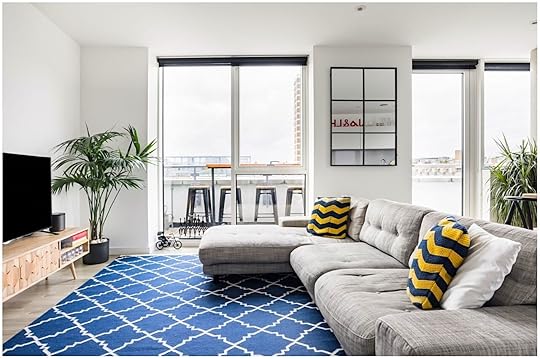
Photo: Airbnb
Stay in this Peckham penthouse if you’re looking for stylish, luxury in South London. The space invites you in with its white and minimal gray decor, lots of greenery, and abstract wall art. The dining area is chic and comfortable with a wooden table and bench, and the bathroom feels luxurious and spa-like with white tiled walls and bamboo decor. One of the best parts of Leroy’s place is the small outdoor patio with more greenery and views overlooking Peckham.
Four guests, two bedrooms
$132 per night

Photo: Airbnb

Photo: Airbnb

Photo: Airbnb
Travel back in time with this 1950s retro apartment in the heart of Greenwich. Funky decor, white and black tiled walls, and many wood finishes make this stylish place feel like home right away. The living room is bold and comfortable with a sectional couch and red leather chaise and functional with a dedicated workspace. Davey’s place has two large double-bed bedrooms that are simple and have a bit of London-inspired decor. Here you’ll be just a short walk away from Greenwich Market–perfect for eating, antique shopping, and people watching–and the famous Greenwich Observatory.
Four guests, two bedrooms
$198 per night

Photo: Airbnb

Photo: Airbnb

Photo: Airbnb
This English-countryside-inspired place is the perfect Airbnb in London’s Clapham neighborhood. The decor, a blend of whites, creams, and off-whites, feels elegant and polished and the bedrooms feature draping floor-length curtains, fireplace mantles, and plush headboards. One of the five bedrooms is ensuite with a white clawfoot tub sat perfectly beneath a skylight window for an extra royal touch. After a long day of exploring London, prepare a meal in the large open-air kitchen and then retreat to the outdoor patio area for comfy garden dining.
Nine guests, five bedrooms
$931 per night
No trip to London is complete without visiting these beloved West London neighborhoods. They are worth exploring, from antique shopping at Portobello Road Market in Notting Hill to polished cafes in Chelsea. And South Kensington has some of the best shopping in town.
9. Notting Hill
Photo: Airbnb

Photo: Airbnb

Photo: Airbnb
Step into the opulent luxury of Mel’s place in Notting Hill. The West London neighborhood is loved for its ritzy flair, and this apartment emulates the same spirit; in this cozy hideaway, the beauty is in the details. From the gold vintage mirror to classic nude art on the walls, this place feels fitting for a stay in Notting Hill. Not just pretty, the space is functional too, with a detected workspace, floating wood kitchen shelves, and french doors for a bit of privacy between the living area and bedroom.
There’s much to explore outside this apartment. The neighboring streets are lined with cafes, restaurants, and plenty of green spaces. On Saturdays, you’ll be just a stroll away from the famous Portobello Road Market, where antique shopping and eating local bits are a must.
Three guests, one bedroom
$181 per night

Photo: Airbnb
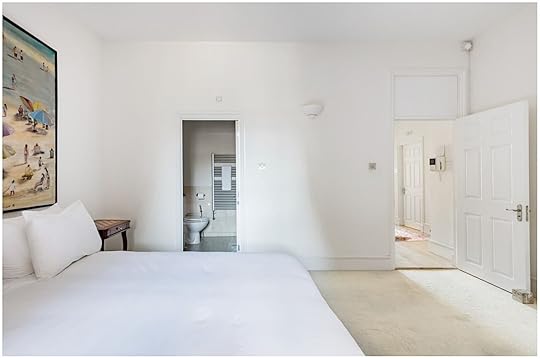
Photo: Airbnb

Photo: Airbnb
This bright Edwardian townhouse is tucked away on a quiet street in the heart of South Kensington. Mo’s place is warm and eclectic, with a cozy living room featuring light wood floors, high ceilings and tall windows, and a framed stamped collection. After exploring London, the dining area features a long wood oak-like table perfect for homemade dinners for four. Nothing seems out of place here while still feeling cosmopolitan and down to earth.
Bedroom one is ensuite and features high ceilings and a king-sized floor mattress. Bedroom two has two single beds perfect for those wanting their own sleep space. And there’s a small balcony here, great for having a cup of tea in the mornings. The apartment is steps away from the Natural History Museum and the Victoria and Albert Museum–well-loved London institutions.
Five guests, two bedrooms
$579 per night

Photo: Airbnb

Photo: Airbnb

Photo: Airbnb
This pastel brick townhouse sits on a beautiful row of color in downtown Chelsea near Sloane Square. Perfect for medium groups looking for a luxurious and comfortable stay in the big smoke. The decor is well designed with soft hues, fine art, a glass mirror wall, and homey details like the living room’s electric fireplace. The elegance continues into the bedroom and bathrooms, especially. There’s a clawfoot tub, rainfall showerheads, and vessel sinks.
Beyond the beauty of this space, the apartment is well connected to some of Chelsea’s best hotspots. On the week, head to Chelsea Farmers Market and brunch at Bluebird.
Seven guests, two bedrooms
$2,554 per night
The cooler cousin of the city, East London, has an effortless cool that can be felt with one step in Dalston, Shoreditch, Hackey, or Bethnal Green. They’re all full of bars and local restaurants. It’s also the perfect place for popping into local art exhibitions or hanging out at breweries like London Fields Brewery.
12. Dalston
Photo: Airbnb

Photo: Airbnb

Photo: Airbnb
Located in one of East London’s coolest neighborhoods, this bright garden home in Dalston is one of the best Airbnb London rentals. The apartment is mid-century modern meets planetarium. The hues are rich, warm, and inviting–an oasis of calm your host, Dewi, explains. From the wood fireplace to original detailed ceilings, this place is a must-stay in Dalston. Natural light pours into every room, and bright yellow, orange, and chartreuse accents in the bedroom, kitchen, and bathroom are sure to catch your eye. Perfect for a small couple of friends or couples, end your nights in the back garden with some local takeaway and drinks.
When you’re ready to explore, check out these Dalston highlights: watch a film at Rio Cinema, chill with freshly made pizza at Dalston Curve Garden, and dance to 80’s pop at Ridley Road Market Bar.
Four guests, two bedrooms
$266 per night

Photo: Airbnb

Photo: Airbnb

Photo: Airbnb
Sleep in a converted warehouse loft in London’s beloved Shoreditch neighborhood. Despite the building’s historical past, the interior decor gives it a modern, contemporary feel. The space has warm timber flooring and features the original exposed brick walls. The bedrooms are decorated with white linens, wooden headboards, and wall plants. The bathroom offers a boutique hotel feel with black matte hardware and marble-tiled walls, and an intimate outdoor patio sits between the living area and bedrooms.
And because Branca’s place is centrally located, you’ll be a stone’s throw away from all the best bars, restaurants, and rooftops along Shoreditch High Street and the Spitalfields area.
Four guests, two bedrooms
$334 per night

Photo: Airbnb

Photo: Airbnb
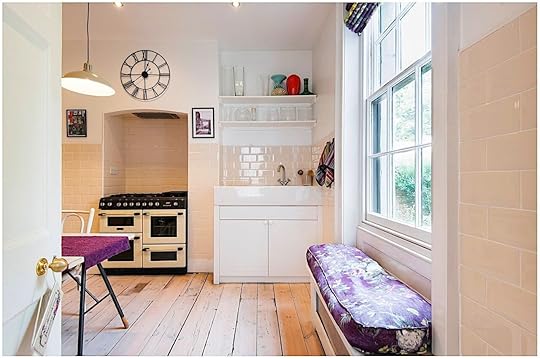
Photo: Airbnb
Step foot into this stunning Georgian home and be transported back in time. This home is one of the best Airbnbs in London and features classic English architecture, vintage decor, and bold abstract artwork. At the entrance, a dramatic spiral staircase greets you and opens up into the living room space, which features dark accent walls, a fireplace, and green velvet chairs. Expect bold pink and green decor with soft details like a vintage glass curved bookcase in the bedrooms. Of course, the English-style bathroom features a gorgeous white and silver clawfoot tub and plenty of natural light.
Outside your doors is the vibrant neighborhood of Hackney. Here you’ll find breweries, endless bars, and cafes. St. James Park, a beautiful, sprawling green space, is just a few minutes away.
Four guests, two bedrooms
$253 per night

Photo: Airbnb

Photo: Airbnb
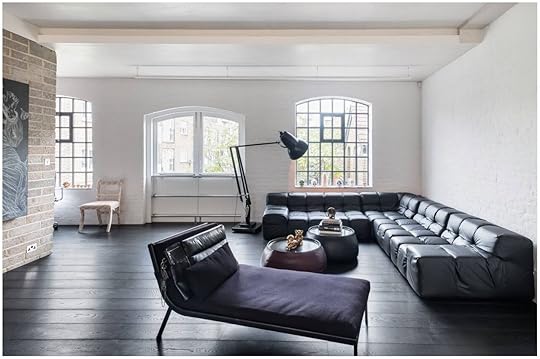
Photo: Airbnb
Tucked behind the quiet cobbled mews in Bethnal Green, this Airbnb London rental is a place of monochrome dreams. This place has the ultimate modern feel, from the black quilted corner sofa to the white brick walls. Contemporary art hangs on the walls, and a matte black bookcase hugs the corner. This warehouse-style Airbnb is open, airy, and minimalistic. Perfect for a solo traveler or a pair, the bedroom features a king-size bed facing floor-to-ceiling windows. And the bathroom is luxurious with a white clawfoot tub and silver hardware finishes. On Sunday morning, stroll over to Victoria Park for banana nut pancakes at Pavillon Cafe.
Two guests, one bedroom
$467 per night
Central London is home to some of the city’s top attractions and the best shopping, like on the iconic Oxford Street. A stay in Victoria, Mayfair, or Soho, means you’ll be close to famous museums and age-old pubs.
16. Victoria
Photo: Airbnb

Photo: Airbnb

Photo: Airbnb
Tucked away in a private mews near Victoria, this is an excellent place for a small group of friends to stay. The decor is calm and well thought out, with luxe velvet chairs and a sofa. The living space is open and perfect for gathering for drinks after a meal in the dining nook. Thanks to the classic London skylights featured here, the two ensuite bedrooms are cozy and well-lit. Its location is perfect for exploring central London neighborhoods like Knightsbridge, Sloane Square, and Victoria.
Four guests, two bedrooms
$337 per night

Photo: Airbnb
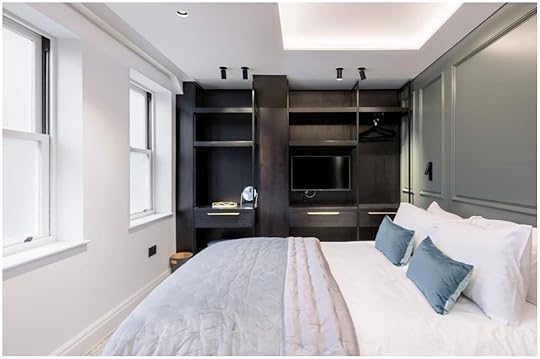
Photo: Airbnb

Photo: Airbnb
Minimalism reigns supreme at this elegant Airbnb in London’s Mayfair neighborhood. Luxury is everywhere, from velvet gray and gold armchairs to rich marble details. The muted hues in the apartment are understated in the best way so that the architecture and design can shine. There are Juliet balconies and gold-trimmed bedroom cabinets. There are marble walls, gold accents, and a standing glass rainfall shower in the bathroom. Jade’s centrally-located place has easy access to shopping around Mayfair and on the famous Oxford street.
Four guests, two bedrooms
$874 per night

Photo: Airbnb
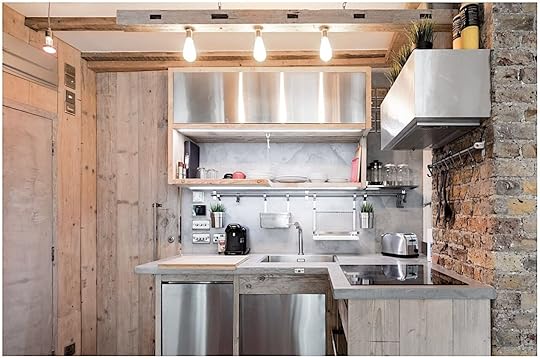
Photo: Airbnb

Photo: Airbnb
In the heart of Soho stands this unique wood and brick suite. Eric’s apartment has a vintage flair with exposed brick walls, unpolished hardwood floors, and furnishings. There are hints of modernity with the minimalistic kitchen and grey plush couch. This place has understated details but remains luxurious with elements like utility-style kitchen storage and sliding barn doors on the bedroom. Perfect for a couple traveling to London, this Airbnb features a king-sized bed with a TV and a beautiful walk-in shower. 
Two guests, one bedroom
$200 per night
December 6, 2021
This is how much it costs for a night out in the world’s top cities

Things have begun to open up worldwide, and this is great news for all of us who enjoy a night out from time to time. Entertainment businesses such as clubs, bars and lounges are back. Most of us know how much is costs to go out in our hometown, but what about in top party spots around the world?
A study published by the site Jewellry Box analyzed the cost of a night out in cities across the United Kingdom, and compared them to top cities around the world. The results may surprise you.
A night out in the UK and abroad can be expensive. It can put a dent in your bank account, but to help choose what’s best for you, no matter if you’re a college student on a budget or someone ready to splurge the night away, here are some of the costs of a night out abroad that can break the bank and fit your budget.
Cheapest cities in the UK
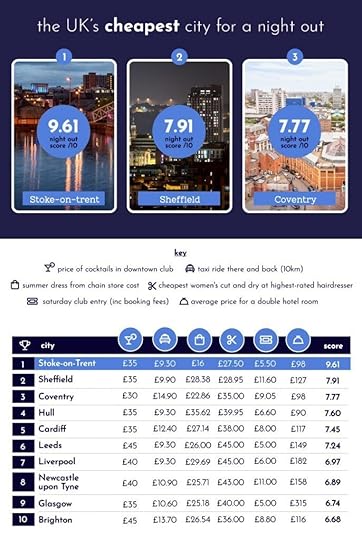
Photo: jewellerybox.com
Expensive cities in the UK
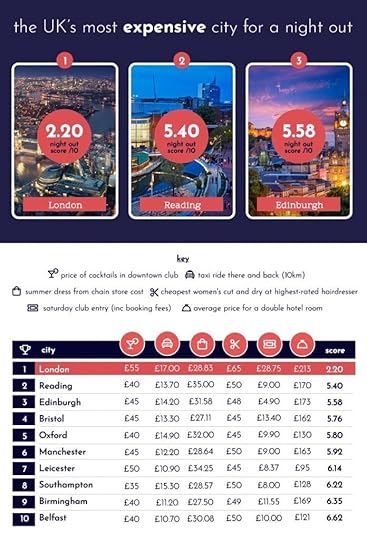
Photo: jewellerybox.com
Thailand is the cheapest for a night out, the study found, with South Africa in second and Brazil coming in on the list as well. Coming in at the top spot for the most expensive country for a night out in the United States, with Australia in second and Germany in third place.
But if you’re ever in the UK looking for some cheaper expenses and to not break the bank, Stoke-on-Trent is the cheapest city for clothing, a haircut, and for a taxi. While Coventry is the most affordable city for cocktails, Edinburgh is the cheapest city for club entry, and Hull is the cheapest hotel room. And Kingston upon Hull, Leeds, and Liverpool are also the most affordable cities in the UK for a taxi.
While other countries like Thailand are the cheapest for hotels and clothing, Argentina for most affordable haircuts, and Brazil for the inexpensive taxis. 
A London museum put a Christmas sweater on a dinosaur, and it’s starting a trend

The holiday spirit has officially taken over every aspect of our lives. If you’re in London, that includes museum visits. The London Natural History Museum has jumped on the festive bandwagon by dressing up one of its dinosaurs in a Christmas sweater.
The animatronic Tyrannosaurus rex, part of the Dinosaur Encounter exhibition at the Natural History Museum, is imposing even at three-quarters the size of a life-size T.rex, but the enormous and sharped-tooth creature looks a lot less scary when it’s sporting a Christmas sweater.
Our animatronic T. rex is getting into the Christmas spirit. It's been kitted out in its very own theropod-size seasonal sweater, made from 100% recycled materials, thanks to @britishxmas.
Get your claws on your own version: https://t.co/p02sVFP2nI#NHMtrexmas pic.twitter.com/ZRhyA0Ubi9
— Natural History Museum (@NHM_London) December 6, 2021
The Christmas sweater was made especially for the T.rex by family-run British company British Christmas Jumper. According to the BBC, it took staff at British Christmas Jumper 100 hours of work to complete the sweater. The effort makes sense when you consider how large the sweater is, except for the sleeves which are tiny, of course.
It’s made from 60 percent recycled cotton and 40 percent recycled polyester, with the latter coming from locally recycled plastic bottles.
Upon seeing the London Natural History Museum’s antics on Twitter, The Manchester Museum decided to dress up its own T.rex in the museum’s Fossil Gallery. Here’s to hoping it starts a trend.
Tomorrow, @McrMuseum are opening the Fossils Gallery for one day only so you can drop off donations for the Christmas Gift Appeal.
You can also get your picture with Stanta Claus! pic.twitter.com/BekkEBAHW8
— The University of Manchester (@OfficialUoM) December 6, 2021
You can get the dinosaur nerds in your life their own dino-motif Christmas sweater in the gift shop of the London Natural History Museum for just $46. All the sales proceeds help support the museum’s mission. 
Matador Network's Blog
- Matador Network's profile
- 6 followers



